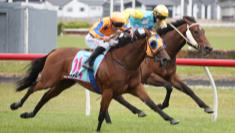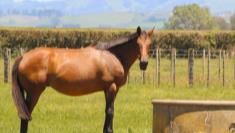.jpg)
Safety of mares and foals paramount in breeding season
Haunui Farm is one of many thoroughbred nurseries around New Zealand experiencing their busiest period of the year, with breeding season in full swing and many hands on deck ensuring the welfare of mares and foals.
Operated by Mark Chitty, Haunui Farm has an experienced team of breeding professionals led by Keith Konn, Bloodstock and Breeding Manager at the stud, who gave an insight to the 24-hour process involved with safely foaling a multitude of mares.
“It all starts in August, mares start to foal so depending on what date of service your mare has, it all starts around the first,” Konn told SENZ - The Rural Roundup.
“Thoroughbred mares generally foal at 11 months and above, then from about five to 10 days following. Mares take a different amount of time to foal, some take 11 months and five days, some take their time.
“We like to keep all of our mares under lights, and we have 24-hour foal watch. Mares generally, with the old adage of being a wild animal, like to foal in the middle of the night.
“10 o’clock at night, to about two in the morning, is where they will be likely to foal.
“We have shift work happening, some people will start at six o’clock and are watching the paddocks through the night, looking at and keeping a close eye on the mares.”
A mare will give clear indication when they are in labour, with the role of Konn and his staff then reliant upon how the following minutes unfold.
“Once a mare has broken waters, she will show a few symptoms of discomfort, their temperature rises, they may start pouring the ground and become a bit aloof from their herd. Once this occurs, the staff will call the senior members of Haunui Farm, who are on-call once a week,” Konn said.
“For example, I was on call last night and we had a foaling at two o’clock this morning, so once the mare broke waters, she (staff member) called me, so I came down to the paddock.
“It’s a very dynamic thing that happens, bringing life into the world, and some of these horses are quite valuable. But, we treat every horse the same, whether they are worth $1,000 or $1 million.
“You have to have your procedures in place, because things can go wrong. Horses are a long-limbed animal and you have to streamline them, ensuring everything is happening normally.
“Nine times out of 10, mares will foal predominantly on their own, and you’re just there to assist. The idea of having foal watch is just for that 10 percent that have trouble, so we can help the mare without stressing her out too much.”
Following birth, the process of taking their first steps, to drinking from the mother, comes at a rapid pace for the newborn foal.
“All things going normally, you’re looking at 15 minutes to 45 minutes (to stand up), some do it quicker, some take a little bit longer,” Konn said.
“The foal will generally show you signs of them trying to get up and some will be a little bit wonky and seem like they are drunk, but after about 45 minutes to an hour, they will be trying to feed from the mare.
“It is very important to use a colostrum meter, we take colostrum and read it and as long as it’s above 20, which is a good gauge, that’s good colostrum.
“Once the foal gets the colostrum, they are using that to build an immune system so it can fight any antibodies.”
Whilst the safety of the mare and her foal is paramount, Konn explained that the staff are cautious of the animals in such a vulnerable state.
“You’ve got to be very careful, you are at the dangerous end of the horse. Not a lot of people get injured at the front, it’s predominantly at the back and that is where all of the action is happening during foaling,” he said.
“You have to keep in mind that you are standing slightly to the side, but most mares that have had a foal before know exactly what is happening.
“We check presentation before to ensure the two front legs are coming first along with the head, and then we just stand back. Mares will usually lie down and relax, then start pushing.”









